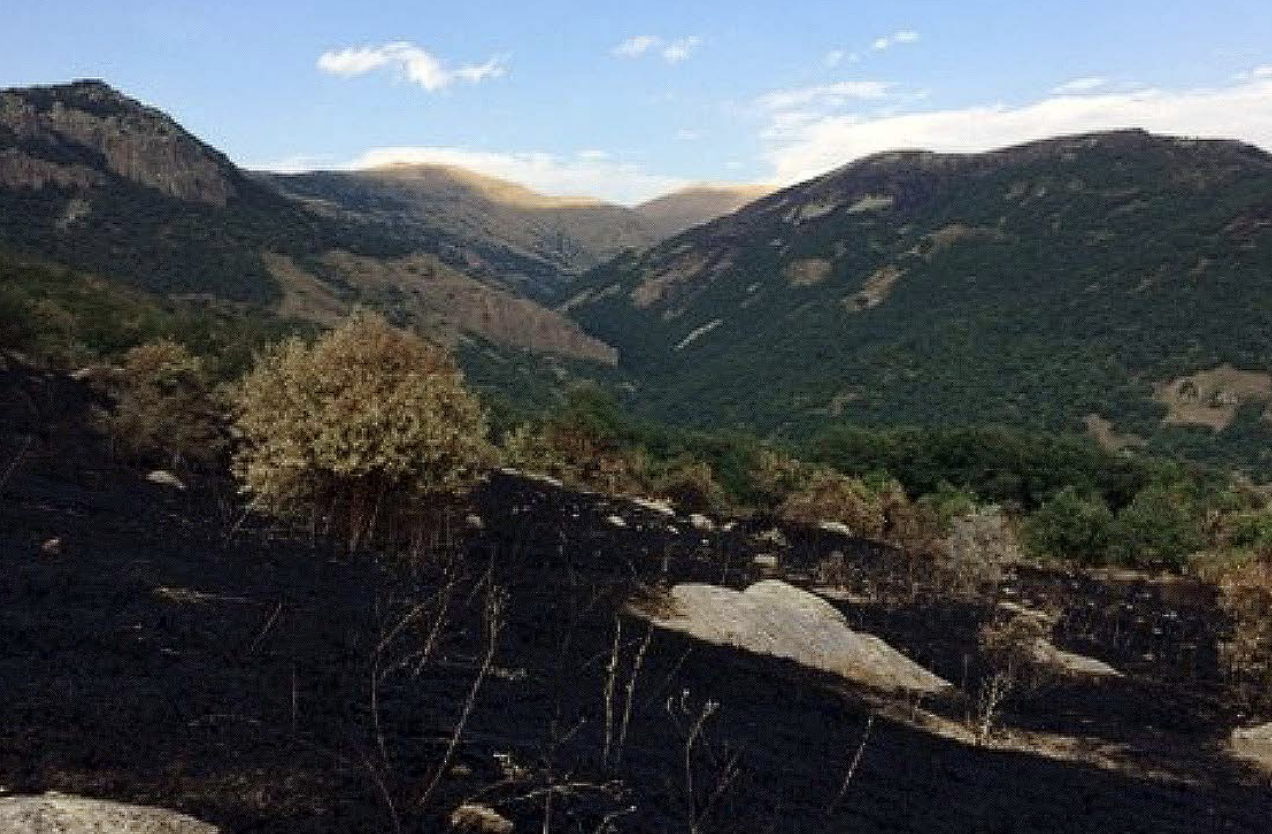Taming Wildfires: Addressing climate change impact through enhanced capacity for wildfires management in Armenia

Summary
This project – “Addressing climate change impact through enhanced capacity for wildfires” – aimed to reduce the risk of wildfires to both Armenian society and its mountain ecosystems. To achieve this, its goals included strengthening wildfire early warning and monitoring systems; improving and enforcing policy and regulatory frameworks; defining roles and responsibilities of respective national structures; and developing technical capacities.
Armenia currently has a tree cover of about 10 per cent of its total surface. Most of its forests are located in the Tavush and Lori regions (72 per cent), but there are also forested areas in mountainous regions across the country. Forest degradation and reduced forest integrity result in biodiversity losses, damages of livelihoods and reduced resilience of forest ecosystems to the impacts of climate change.
With an average temperature increase of 1.03°C since records began at the turn of the twentieth century, and an overall average decline in precipitation of 9 per cent compared with the baseline period 1961-1990, Armenia has become more vulnerable to forest fires over the last few decades. Between January 2012 and October 2021, the country experienced a total of 2,464 Visible Infrared Imaging Radiometer Suite (VIIRS) events, in which thermal anomalies are detected by satellites. As a result of prevailing drought conditions and continued hot temperatures, wildfires have caused extensive damage to mountain ecosystems.
Under the observed and projected changes in Armenia’s climate, further aridification creates conditions for more frequent and more intense wildfires. The mountain forests of South Caucasus, where fires were not an intrinsic factor for many years, thus have become much more vulnerable and sensitive.
Forest fires are often caused by the burning of agricultural residue after harvest in lands adjacent to forests. This practice coincides with the highest risk period for wildfires in July to September, when also heatwaves are most likely. Recent models for Armenia project a potential increase of the annual probability of a heatwave to 18 per cent under a high emission scenario by the end of the century. Due to the close interrelation of climatic factors and wildfires, fire regimes respond rapidly to climate change and climate variability. Changing climate conditions can lead to lengthened fire seasons, and more frequent droughts and heatwaves could significantly exacerbate the risk of forest fires in Armenia.
Overview
- Location:
- Implementation sites:
-
- Single country
- Multiple locations
- Mountain region:
-
Gegham range
- Province:
-
- The provinces of Lori and Ararat
- Solution scale:
- Ecosystem type(s):
- Solution type(s):
- Sector(s):
- Climate impact(s) addressed:
- Climate impact time-scale(s):
- Main benefit associated with the solution:
- Co-benefit(s) associated with the solution implementation:
- Implementation timeline:
-
- 2017 - 2021
Solution details
Main beneficiaries & outcomes
This solution improved Armenia’s policies and tools to combat forest fires, and maintain forest cover and biodiversity, in the context of warming temperatures:
- The new EWS covers over 27,367 hectares of forest, especially in the country’s biodiversity rich ecosystems. Khosrov Forest State Reserve was specifically targeted with improved weather forecasting, and communication networks that was an issue when coordinating forces to fight forest fires.
- Over 56,865 people from 3 consolidated communities with 32 settlements have benefited from these measures.
- New and upgraded equipment (five off-road vehicles and 12 water tanks for off-road vehicles) were distributed to ensure the accessibility to remote and difficult forest locations during the wildfire emergency response.
- Overall, 360 firefighters, 30 of them women, received training and proper equipment in combating fires in remote mountainous terrain.
Planning and implementation
This project was implemented by Armenia’s Ministry of Environment. It started in 2017 and was completed in 2021.
The overall goal of the project “Addressing climate change impact through enhanced capacity for wildfires management in Armenia” was to strengthen wildfire early warning and monitoring systems, improve and enforce relevant policy and regulatory frameworks, define roles and responsibilities of respective national structures, and develop necessary technical capacities at national and local levels.
For revising and updating policy and legislation for the prevention of wildfires as part of the sustainable forest management system in the country, the drafting of the Law on “Disaster Risk Management and Population Protection” has been supported and submitted to the Government for endorsement in 2020. This included specific inputs on wildfire management at national and local levels, while also addressing gender responsive and risk informed development mechanisms.
To strengthen technical capacities, the government decided to establish an operational early warning system (EWS) under the auspices of the Inter-Governmental Task Force coordinated by the Ministry of Emergency Situations. In total 10 EWS were procured and installed in the Gegharkunik and Syunik regions of Armenia. The systems were integrated with the existing national EWS thus ensuring the proper management and dissemination of the wildfire warnings to the communities located nearby the forests or Specially Protected Areas. In addition, community administration representatives were trained on the installation and use of these EWS, fostering gender-balanced participation. Also, a digital platform was created for wildfire management and the use of EWS, now managed under the Ministry of Environment.
Moreover, two new weather stations were installed in the territory of the Khosrov Forest State Reserve in March 2021, which are now able to deliver accurate data and forecasts for wildfire risk with significantly improved accuracy, lead time and spatial resolution. This will help authorities to predict, detect and warn of forest fires more efficiently.
In addition to the preventive measures, training was delivered on minimizing fire damage. The training included innovative EbA measures from the Food and Agriculture Organization of the United Nations (FAO) forest and landscape restoration course, targeting forest authorities and surrounding communities. Furthermore, firefighters were provided with new equipment to improve efficiency during their interventions. For better access to forests, and particularly protected areas, off-road vehicles were provided, and water tanks added to improve fire suppression activities in remote and hard-to-reach forest locations. Due to their rugged terrain, mountain regions are particularly troublesome for firefighters, making appropriate equipment crucial.
Finally, a new forest management agreement, the first of its kind, was established between the NGO Lore Rescue Team in the communities of Stepanavan and Tashir (Lori region) and the government. The project coordinators emphasized that actions are needed at several levels, including coordination at the policy level, strengthening of the relevant institutions, and support for firefighters on the ground, to efficiently improve forest fire suppression.
Finance
The project “Addressing climate change impact through enhanced capacity for wildfires management in Armenia” received funding from the Russian Federation and the United Nations Development Programme. It had a total budget of 3,230,000 USD over four years (2017-2021). Their total contributions upon project completion equated to $1,351,555.
Innovation
The project deeply influenced the current forest/wildfire management system through legal and institutional frameworks, fire and early warning management systems, and coordination procedures. It has introduced innovative ecosystem-based adaptation measures targeting both the forest authorities and surrounding communities.
Performance evaluation
Upon its completion, the project was evaluated and received a ‘satisfactory’ rating. The project faced some resource challenges associated with the COVID-19 pandemic and post-conflict humanitarian crisis. Yet, it was seen to empower women in the region and there are plans in place to implement and scale-up the project in the future. View the Closure Stage Quality Assurance report for further details.
Long term project sustainability and maintenance
The broad approach taken to combine activities that strengthen technical capacities, improve forecasting and weather services and foster national policy integration, helps ensuring sustainability and secures embedding in existing structures. While the overall maintenance of the procured EWS was handed over to and will be carried out by communities, the overall coordination and accountability lies with the Ministry of Emergency Situations. Thus, an important success factor is the vertical and horizontal coordination between local and national actors and institutions. Also, the nationwide integration of the installed EWS and weather stations ensures proper embedment into an existing system of early warning and data management.
Capacities for design and implementation
Knowledge
Local communities and forest authorities were given access to training on how to minimise fire damage and ecosystem-based adaptation methods.
Technology
Procuring and adding to existing technologies were key to increasing the effectiveness of wildfire management in this solution. Early warning systems and weather stations were installed to increase the scope and accuracy of warning dissemination and wildfire risk forecasts. The Lore rescue team also used drones to monitor forest activities, further helping the region to prepare for wildfires and manage them accordingly.
Political / Legal
To improve wildfire management at both local and national scales, the solution involved the drafting of “Disaster Risk Management and Population Protection” law which was submitted to the government in 2020.
Institutional
This solution also helped to shift the relationship between rescue volunteers and state institutions (e.g. the neighbouring forest enterprises) from being cooperative to having formalised partnerships. This has strengthened the integration of volunteers into the state-run operations, specifically by placing the volunteer component into the operational management chain. The agreement signed provides clear understanding on the limits and expectations of volunteer involvement, as well as on mutual responsibilities when using the volunteer forces.
Outlook & Scalability
Potential for upscaling and replication
Further replication possibilities in other forest areas of Armenia are being considered. Also, beyond the country, this inclusive approach is equally suitable in regions with a similar climate and landscape, including hilly and mountainous terrain, that face increased risk of wildfires due to climate change and the need to establish an operational disaster risk management system.
The project serves as a study case in terms of both, the approach and implementation mechanisms. It is an example of small and affordable adaptation solutions, which the community could initiate and handle itself through consolidation of existing capacities. The existence of local level adaptation plan is a good starting point and a marketing instrument to attract donors seeking additional funding if required.
- Seizing local opportunities in Armenia
- Taking Action Together for Resilient Mountain Communities in the South Caucasus
- Chkhaveri Vineyards Against Land Erosion in Keda Municipality, Georgia
- Addressing climate change impact through enhanced capacity for wildfires management in Armenia
- Restoring lost water resources in the Shirak region of Armenia
- Addressing climate change impact through enhanced capacity for wildfires management in Armenia




Comments
There is no content